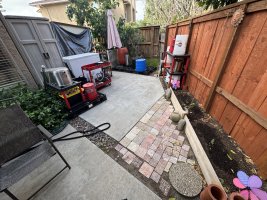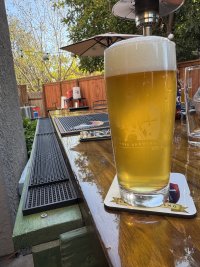I_Brew_Too
New Member
Howdy all, my name is Mark. Glad to be here!
I've been fortunate enough to have tons of great breweries open in my area the past few years. I get booked as an Singer-Acoustic Performer at most of these places, so I get to sample a lot of beer and talk with a lot of brewers and fellow beer lovers.
One day, the wind blew me the right way and I decided to try an extract kit from MoreBeer. It was awesome...but I didn't realize that chlorine would leave me with a band-aid like after taste!
That being said, it was still inspiring to drink my own home brewed beer. I've since moved to BIAB and keg carbonating. I've brewed about 6 batches total so far. All except one have turned out pretty awesome.
I like to brew two batches at the same time. Usually, a West Coast IPA/Pale Ale and a blonde. I want to dial in a few "staple" recipes and then experiment with other styles once I've mastered my processes more.
I love the balance between creativity, theory and science that homebrewing offers. The rules are ridged, kind of like music! This site has been an amazing resource. Reading about what has and hasn't worked for other brewers has helped speed up my learning curve and has kept me engaged.
My question for other brewers - what was the most significant piece of advice or equipment that took your beer from "hey! That's pretty good!" to "Holy ****! This is AMAZING!"?
Here's a picture of my current setup and a pour of my most recent session IPA! Cheers!

I've been fortunate enough to have tons of great breweries open in my area the past few years. I get booked as an Singer-Acoustic Performer at most of these places, so I get to sample a lot of beer and talk with a lot of brewers and fellow beer lovers.
One day, the wind blew me the right way and I decided to try an extract kit from MoreBeer. It was awesome...but I didn't realize that chlorine would leave me with a band-aid like after taste!
That being said, it was still inspiring to drink my own home brewed beer. I've since moved to BIAB and keg carbonating. I've brewed about 6 batches total so far. All except one have turned out pretty awesome.
I like to brew two batches at the same time. Usually, a West Coast IPA/Pale Ale and a blonde. I want to dial in a few "staple" recipes and then experiment with other styles once I've mastered my processes more.
I love the balance between creativity, theory and science that homebrewing offers. The rules are ridged, kind of like music! This site has been an amazing resource. Reading about what has and hasn't worked for other brewers has helped speed up my learning curve and has kept me engaged.
My question for other brewers - what was the most significant piece of advice or equipment that took your beer from "hey! That's pretty good!" to "Holy ****! This is AMAZING!"?
Here's a picture of my current setup and a pour of my most recent session IPA! Cheers!





